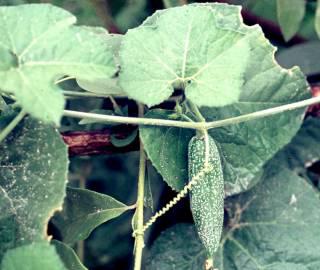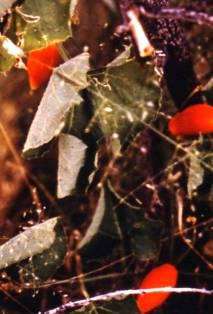Kedrostis hirtella
Kedrostis hirtella (Naudin) Cogn.
Family: Cucurbitaceae
Common names: bobbejaankomkommer (Afr.); mogakangwaga (Tswana)
Introduction
This climber, with bright green velvety leaves, bears bright orange-red fruit that will attract birds to your garden.
Description
Description
Perennial herb. Rootstock tuberous, ovoid to spindle-shaped, up to 200 x 100 mm, bark brown, flesh bright yellow. Stems annual, finely ridged, sparsely hairy, up to 2 m long, climbing in trees, shrubs and grasses, also prostrate if no support is available, cut stems exude no sap. Leaves broadly ovate to pentagonal in outline, base heart-shaped, unlobed to deeply palmately 3-5-lobed, up to 110 x 75 mm, bright green above and paler below, densely hairy on both sides, especially on the prominent veins beneath, leaf edges finely toothed, crushed leaves non-aromatic. Leaf stalks hairy, up to 60 mm long. Tendrils usually with two branches.
Flowers either male or female, both appearing on the same plant (monoecious), greenish white to greenish yellow. Male flowers more or less 5-11 in about 50 mm long inflorescences, petals 3.5-5.0 mm long, stamens and pollen orange. Female flowers solitary, petals 6-8 mm long, stigma orange. K. hirtella flowers from October to April, but mainly in January.
The fruiting time is from November to April, but also mainly in January. Fruit cylindrical to somewhat spindle-shaped, rounded at the base, tip beaked, up to 100 x 25 mm, smooth and hairless, green with pale green or white speckles longitudinally arranged, becoming yellow to bright orange-red, splitting lengthwise when ripe, pulp orange to red, bright red around seeds. Seeds 18-20 per fruit, up to 6 mm across, subglobose, edges prominent, smooth, dark brown, drying grey to whitish.
Distribution and habitat
Distribution description
K. hirtella is indigenous to Africa and occurs mainly in the drier regions from Senegal to Namibia, Botswana, South Africa and Swaziland. In South Africa it is found in the North-West, Gauteng, Mpumalanga, KwaZulu-Natal, Northern and Eastern Cape. It is rare in the Eastern Cape and is absent from the very dry parts of the Northern Cape as well as the winter rainfall area.
In southern Africa it grows from 70-1 525 m altitude in low to fairly high rainfall areas, from about 250-1 000 mm annually. It thrives in shady spots but can also grow in full sun. At least the underground parts are frost hardy.
This species usually grows in deep sandy or red loamy soil, also well-drained, sandy quartzite and stony soil. It has been collected on 'powdery brown brackish loam', loose shale and loam as well as coarse sand in dry river beds. It has even been found growing on a termitarium within a floodplain. K. hirtella is often seen on granite outcrops and dolomite mountain slopes where it grows on all aspects. The surrounding vegetation can be grassland, savanna, various kinds of woodland with several species of Acacia, and also forest.
Derivation of name and historical aspects
History
The genus name Kedrostis is the classical Greek name for white bryony, Bryonia dioica, another member of the Cucurbitaceae, indigenous to the Mediterranean area ( Jackson 1990). Kedrostis is a genus of about 25 species in the Old World, mainly the tropics; most species are in Africa. The species name hirtella means minutely hirsute or hairy and refers to the short, fairly coarse and stiff straight hairs that are found mainly on the leaves of this species. K. hirtella was previously known as K. natalensis (Hook.f.) A.Meeuse.
The Cucurbitaceae consists of about 120 genera and 735 species that are cosmopolitan in mostly tropical and subtropical countries. Many species are cultivated and of economic importance as food plants such as cucumber, melon, pumpkin and watermelon. Members of this family are annual or perennial herbs or shrubs (only one species is a tree). The leaves are alternate and variable and tendrils are almost always present. The flowers are mostly unisexual and white or yellow; they occur on the same plant (monoecious) or on separate plants (dioecious). The fruit often is an indehiscent berry (soft-shelled) or gourd (hard-shelled) with one to many, often flattened seeds. There are about 18 genera and 75 species of this family in southern Africa. The family name refers to the pumpkins, species of Cucurbita, all originally from the Americas.
Ecology
Ecology
Presumably the flowers are visited by various insects, such as bees, ants and flies.
Uses
Use
According to Watt & Breyer-Brandwijk (1962), K. hirtella is reported to be poisonous and it is also mentioned as a Ngamiland poison. One case of fatal poisoning from the use of the plant as a medicine is reported from the Transkei. Some plant collectors wrote that the fruit is not eaten by humans, while others noted that the raw, red fruit is said to be edible. It has been observed that birds eat the fruit.

The tuber of this species is used to make khadi, an alcoholic beer. The roots of several other plant species can also be used to make khadi. According to Van Wyk & Gericke (2000), the most well-known is Khadia acutipetala (khadi root or khadiwortel) which is a member of the Mesembryanthemaceae and grows in North-West and Gauteng.
Prof. J.W. Snyman, who made a study of the Tswana names and uses of plants in the 1970s, gave a recipe for making khadi, using K. hirtella. This appears on the label of his specimen number 101 that was collected in the Zeerust area, and is now filed in the National Herbarium, Pretoria. First the root is peeled, then pounded, dried and ground. This flour is then mixed with tepid water. Finally young bees (!) are added and the mixture left for two or three days to ferment before it can be drunk.
Growing Kedrostis hirtella
Grow
This species is not discussed in any of the standard horticultural books on indigenous South African plants. However, its natural habitat and ecology can be used as guidelines. K. hirtella can be grown from seed in most areas, as long as the young plants are protected against drought, severe frost and too much sunlight. As a climber, the stems will need some support to give a showy effect. The main attraction of this plant is the bright red mature fruit that will attract birds. It is unsafe for humans to eat the fruit!
References
- Jackson, B.D. 1960. A glossary of botanic terms. Duckworth, London.
- Jackson, W.P.U. 1990. Origins and meanings of names of South African plant genera. Ecolab, Botany Dept., University of Cape Town.
- Jeffrey, C. 1978. Cucurbitaceae. Flora zambesiaca 4: 484-487.
- Meeuse, A.D.J. 1962. The Cucurbitaceae of southern Africa. Bothalia 8: 36, 37.
- Van Wyk, B-E. & Gericke, N. 2000. People's plants. A guide to useful plants of southern Africa. Briza Publications, Pretoria.
- Watt, J.M. & Breyer-Brandwijk, M.G. 1962. Medicinal and poisonous plants of southern and eastern Africa, edn 2. Livingstone, Edinburgh & London.
Credits
Mienkie Welman
National Herbarium, Pretoria
March 2005
Plant Attributes:
Plant Type: Climber
SA Distribution: Eastern Cape, Gauteng, KwaZulu-Natal, Mpumalanga, North West, Northern Cape
Soil type: Sandy, Loam
Flowering season:
PH:
Flower colour: Green, White
Aspect: Shade
Gardening skill: Average
Special Features:
Horticultural zones










Rate this article
Article well written and informative
Rate this plant
Is this an interesting plant?
Login to add your Comment
Back to topNot registered yet? Click here to register.